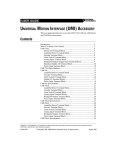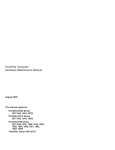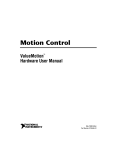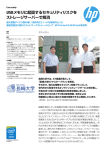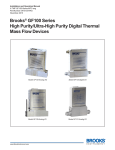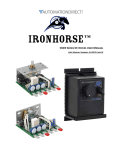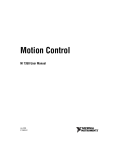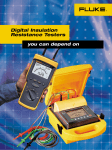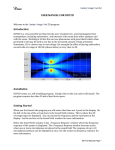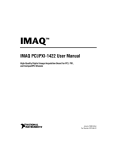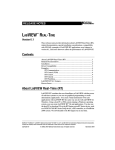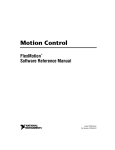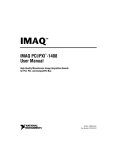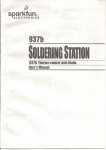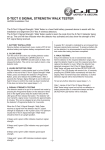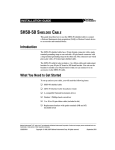Download nuDrive Accessory - National Instruments
Transcript
USER GUIDE NUDRIVE ACCESSORY This user guide describes the electrical and mechanical aspects of the nuDrive power amplifier accessory and describes how to use the nuDrive with your motion controller. Contents Conventions ............................................................................................ 2 Introduction ............................................................................................. 2 What You Need to Get Started ............................................................... 5 Safety Information .................................................................................. 5 Installation and Connector Wiring.......................................................... 6 Front Panel Switches and Host Bus Interlock Circuit............................. 6 Rear Panel Connector Wiring ................................................................. 7 Motor Power Terminal Blocks ........................................................ 7 Encoder Terminal Blocks ................................................................ 8 Limit Switch Terminal Blocks......................................................... 11 CX and SX nuDrive Configuration .......................................... 11 CF nuDrive Configuration........................................................ 12 I/O Terminal Blocks ........................................................................ 13 CX and SX nuDrive Configuration .......................................... 13 CF nuDrive Configuration........................................................ 15 Amplifier/Driver Command Signals....................................................... 16 Servo Amplifier Signals................................................................... 16 Stepper Driver Signals ..................................................................... 16 Optional Configurations.......................................................................... 16 E-Stop Terminal Block .................................................................... 16 Servo Amplifier Configurations ...................................................... 17 Adjusting Current Gain and Current Limits ............................. 19 Balancing the Amplifier Gain................................................... 21 Status LEDs .............................................................................. 22 Stepper Driver Configurations......................................................... 23 Stepper Motor Current.............................................................. 24 Microstep Selection .................................................................. 26 Stepper Motor Configurations ................................................................ 26 Specifications .......................................................................................... 29 FlexMotion™, National Instruments™, ni.com™, nuDrive™, and ValueMotion™ are trademarks of National Instruments Corporation. Product and company names mentioned herein are trademarks or trade names of their respective companies. 321942B-01 © Copyright 1998, 2000 National Instruments Corp. All rights reserved. January 2000 Conventions The following conventions are used in this manual: This icon denotes a note, which alerts you to important information. This icon denotes a caution, which advises you of precautions to take to avoid injury, data loss, or a system crash. This icon denotes a warning, which advises you of precautions to take to avoid being electrically shocked. ♦ The ♦ symbol indicates that the following text applies only to a specific product. overline Indicates the signal is active-low. italic Italic text denotes emphasis, a cross reference, or an introduction to a key concept. This font also denotes text that is a placeholder for a word or value that you must supply. CF nuDrive Refers to the 4CF-001 and 2CF-001 nuDrives. CX nuDrive Refers to the 4CX-001 and 2CX-001 nuDrives. SX nuDrive Refers to the 4SX-211, 2SX-211, 4SX-411, and 2SX-411 nuDrives. stepper nuDrive Refers to the 4SX-211, 2SX-211, 4SX-411, and 2SX-411 nuDrives. servo nuDrive Refers to the 4CF-001, 2CF-001, 4CX-001, and 2CX-001 nuDrives. Introduction Your nuDrive accessory is a complete power amplifier and system interface for use with up to four axes of simultaneous or independent servo or stepper motion control. Ideally suited to industrial and laboratory applications, your nuDrive has everything you need to connect motors, encoders, limit switches, I/O, and other motion hardware to National Instruments motion controllers. nuDrive Accessory User Guide 2 www.ni.com Table 1 lists the available nuDrives and describes the properties of each nuDrive. AC Input Driver/Amplifier Type Driver/Amplifier Nominal Bus Voltage Motion Board Cable Connector Motor Type Number of Axes nuDrive Type Table 1. nuDrive Properties 4SX-411 4 Stepper (2-phase) 50-pin 40 VDC Bus Microstepping Driver IM483 115 V (50/60 Hz) 2SX-411 2 Stepper (2-phase) 50-pin 40 VDC Bus Microstepping Driver IM483 115 V (50/60 Hz) 4SX-211 4 Stepper (2-phase) 50-pin 24 VDC Bus Microstepping Driver IM483 115 V (50/60 Hz) 2SX-211 2 Stepper (2-phase) 50-pin 24 VDC Bus Microstepping Driver IM483 115 V (50/60 Hz) 4CX-001 4 DC Brush Servo 50-pin 48 VDC Bus DC Brush Servo Amplifier SSA 8/100 115 V (50/60 Hz) 2CX-001 2 DC Brush Servo 50-pin 48 VDC Bus DC Brush Servo Amplifier SSA 8/100 115 V (50/60 Hz) 4CF-001 4 DC Brush Servo 100-pin 48 VDC Bus DC Brush Servo Amplifier SSA 8/100 115 V (50/60 Hz) 2CF-001 2 DC Brush Servo 100-pin 48 VDC Bus DC Brush Servo Amplifier S SA 8/100 115 V (50/60 Hz) The nuDrive can drive a broad range of servo or stepper motors. Servo nuDrives use pulse-width modulation (PWM) amplifiers with a user-specified peak output current rating and a DC bus voltage to drive servo motors. Stepper nuDrives use a rugged microstepping bipolar chopper driver. Stepper driver configurations are available in a wide range of user-specified current per phase and voltage settings to drive stepper motors. In all configurations, power supplies are built in and use standard 115 VAC for operation. Electronics are fan cooled to assure reliable operation. nuDrives simplify your field wiring through separate encoder, limit switch, and motor power removable screw terminal connector blocks for each axis. The terminal blocks do not require any special wiring tools for installation. Refer to Table 2 for a summary of how to connect various motion controllers to different nuDrives. © National Instruments Corporation 3 nuDrive Accessory User Guide Table 2. nuDrive Connectivity Controller Connection nuDrives All 7344 controllers SH68-C68-S cable with a 68M-50F step/servo bulkhead cable adapter 4SX-411 2SX-411 4SX-211 2SX-211 4CX-001 2CX-001 All FlexMotion-6C controllers SH100-100-F shielded cable cable 4CF-001 2CF-001 All 7324/7314 controllers* SH68-C68-S cable with a 68M-50F step/servo bulkhead cable adapter 4SX-411 2SX-411 4SX-211 2SX-211 Non-73xx ValueMotion stepper controllers SH50-50 shielded cable or NB1 ribbon cable 4SX-411 2SX-411 4SX-211 2SX-211 All ValueMotion servo controllers SH50-50 shielded cable or NB1 ribbon cable 4CX-001 2CX-001 *For PXI-7324/7314 controllers prior to Rev. C, make the connection using a SH68-68-S cable with a 68M-50F step/servo bulkhead cable adapter. nuDrives have three levels of amplifier inhibit/disable protection for motion system shut down. The front panel contains both enable and power switches for direct motor inhibiting and system power-down operations. Each nuDrive also has a host bus power interlock that activates an amplifier inhibit signal if the host computer is shut down or the motion controller interface cable is disconnected. On nuDrives with the emergency stop (E-Stop) option enabled, you can wire a 115 V emergency stop switch to the rear panel I/O connector for remote interlock shut down, as described in the E-Stop Terminal Block section of this document. Each nuDrive is packaged in a rugged aluminum enclosure that can be used as a benchtop unit or that can be rack-mounted. nuDrive Accessory User Guide 4 www.ni.com What You Need to Get Started To set up and use your nuDrive accessory, you will need the following items: ❑ The nuDrive accessory and nuDrive Accessory User Guide ❑ Power cord (IEC type) ❑ One or more of the following National Instruments cables and adapters: – SH68-68-S shielded cable, part number 185262-02 – NB1 ribbon cable, part number 180524-20 – SH50-50 shielded cable, part number 185319-02 – SH100-100-F shielded cable, part number 185095-02 – SH68-C68-S shielded cable, part number 186381-02 – 68M-50F step/servo bulkhead cable adapter, part number 185630-01 ❑ (Optional) ISO power supply (for FlexMotion-6C boards) Detailed specifications for the nuDrive accessory are in the Specifications section later in this guide. Safety Information Warnings Keep away from live circuits. Do not remove equipment covers or shields unless you are trained to do so. Hazardous voltages may exist even when the equipment is turned off. To avoid a shock hazard, do not perform procedures involving cover or shield removal unless you are qualified to do so and disconnect all field power prior to removing covers or shields. Do not operate damaged equipment. The safety protection features built into this device can become impaired if the device becomes damaged in any way. If the device is damaged, turn the device off and do not use until service-trained personnel can check its safety. If necessary, return the device to National Instruments for service and repair to ensure that its safety is not compromised. Do not operate this equipment in a manner that contradicts the information specified in this document. Misuse of this equipment could result in a shock hazard. Do not substitute parts or modify equipment. Because of the danger of introducing additional hazards, do not install unauthorized parts or modify the device. Return the © National Instruments Corporation 5 nuDrive Accessory User Guide device to National Instruments for service and repair to ensure that its safety features are not compromised. When connecting or disconnecting signal lines to the nuDrive terminal block screw terminals, make sure the lines are powered off. Potential differences between the lines and the nuDrive ground create a shock hazard while you connect the lines. Connections, including power signals to ground and vice versa, that exceed any of the maximum signal ratings on the nuDrive device can create a shock or fire hazard or can damage any or all of the boards connected to the nuDrive chassis, the host computer, and the nuDrive device. National Instruments is not liable for any damages or injuries resulting from incorrect signal connections. Installation and Connector Wiring Be sure to turn off the enable switches and the main AC power to your nuDrive and host computer before connecting to your motion controller. Caution Connect the motion controller to the nuDrive interface cable. Wire the motor power, limit switch, encoder, I/O, and E-Stop terminal blocks as per the instructions and diagrams in this manual and/or your specific system requirements. Finally, install the power cord into the rear panel AC connector and plug it into a correctly rated power source. Note For 50-pin ribbon cable interconnection, be certain that the colored indicator strip (pin 1) on the cable between the motion controller and the 50-pin connector on the rear of the nuDrive is properly aligned and inserted on both ends. 68- and 100-pin cables are keyed metal-shell style. Front Panel Switches and Host Bus Interlock Circuit There are two lighted rocker switches on the nuDrive front panel, POWER and ENABLE. The POWER switch energizes the DC bus and the logic power supplies (+5 V, +12 V), and illuminates to indicate that the main AC power is present. If the POWER switch fails to illuminate, check the power cord and main input fuse in the power connector. The ENABLE switch enables or inhibits the servo amplifiers or stepper drivers. It illuminates to indicate that it is switched on and that the logic power supply +12 V output is functioning. nuDrive Accessory User Guide 6 www.ni.com Either switch can turn off the motors. However, as long as the nuDrive POWER switch is still on, independent power and enable circuits cause the incremental encoders to continue to track motor position while the amplifiers (drivers) are disabled by the ENABLE switch being off. Note The ENABLE switch illuminates whenever it is switched on. It does not indicate that the amplifiers/drivers are disabled under the following conditions: E-Stop active (see E-Stop Terminal Block), host bus interlock fault, or amplifier/driver protection fault (over current, over temperature, and so on). Conversely, it does not light if the remote enable function is used because the ENABLE switch is off (see I/O Terminal Blocks). The nuDrive has a host bus interlock circuit that monitors the presence of +5 V from the host computer and disables the nuDrive when the voltage disappears or falls out of tolerance. This circuit shuts down the motors by activating the Inhibit, or disable circuit for all axes, when the host computer is disconnected from the nuDrive or inadvertently or unexpectedly shut down. Rear Panel Connector Wiring Motor Power Terminal Blocks For motor power wiring on the nuDrive, each axis has a separate 5-position terminal block with removable screw terminals. There are two types of wiring from the same connector for typical operation. Which of these two configurations you use depends upon whether you are using the servo or stepper version of the nuDrive. Figure 1 shows a typical servo motor configuration pin assignment. Figure 2 shows a typical stepper motor configuration pin assignment. Note The dotted loop indicates a shielded cable. + Motor + Motor – Motor Case Ground – Shield Servo Motor 1 2 3 4 5 Figure 1. Typical Servo Motor (DC Brush Type) Terminal Block Pin Assignment © National Instruments Corporation 7 nuDrive Accessory User Guide Winding A Start Winding A End Motor Case Ground Winding B Start Winding B End Stepper Motor 1 2 3 4 5 Shield Figure 2. Typical Full-Coil Stepper Motor (2-Phase Type) Terminal Block Pin Assignment It is recommended you use shielded, 20 AWG wire or larger for the motor power cable. If available, you should connect a case ground wire to pin 3 (Ground/Shield); this helps to avoid ground loops and signal noise problems. (Case ground connects to the motor housing, and not to any of the motor power terminals.) The stepper nuDrives contain bipolar chopper drivers. The stepper motors must be wired in a four-wire configuration as shown in Figure 2. Unused lead wires must be isolated and not connected. See Stepper Motor Configurations for additional information on connecting 6- and 8-wire motors and on the alternate half-coil configuration. Caution Never connect unused center taps or winding terminals to pin 3. Encoder Terminal Blocks For quadrature incremental encoder signals, each nuDrive axis has a separate 8-position terminal block with removable screw terminals. Where applicable, the nuDrive accepts two types of encoder signal inputs: single-ended (TTL) or differential line driver. You can accommodate open-collector output encoders by using 2.2 kΩ pullup resistors to +5 VDC. Figure 3 shows the typical encoder wiring pin assignment for single-ended signal input. Figure 4 shows the typical encoder wiring pin assignment for differential line driver signal inputs. nuDrive Accessory User Guide 8 www.ni.com Phase A Phase B Index +5 V Common 1 2 3 4 5 6 7 8 Figure 3. Typical Single-Ended Encoder Wiring Pin Assignment Phase A Phase A Phase B Phase B Index Index +5 V Common 1 2 3 4 5 6 7 8 Figure 4. Typical Differential Line Driver Encoder Wiring Pin Assignment If the encoder cable length is greater than 15 ft, you should use encoders with line driver outputs for your applications. Power for a +5 V encoder is available on pin 7, generated by a power supply inside the nuDrive. Note If you require other encoder power values, reference an external power supply to the Common (ground) signal on the 8-pin encoder terminal block. nuDrives have differential inputs for Phase A, Phase B, and Index signals. You can easily accommodate encoders with various phase relationships by swapping the signals and/or connecting them to the inverting inputs as specific applications require. The index pulse must occur when both Phase A and Phase B signals are logic low, as shown in Figure 5. If the Index pulse is inverted, try reversing the Index and Index signals on differential encoders or wiring to the Index input with single-ended wiring. © National Instruments Corporation 9 nuDrive Accessory User Guide Figure 5 shows the proper encoder phasing for CW (forward) motor rotation. Phase A Phase B Index Figure 5. Encoder Signal Phasing, CW Rotation Servo and closed-loop stepper applications require consistent directional polarity between the motor and encoder for stable operation. The National Instruments motion control standard directional polarity is as follows: • Positive = forward = clockwise (CW) facing motor shaft • Negative = reverse = counter-clockwise (CCW) facing motor shaft Figure 6 shows the clockwise and counter-clockwise motor rotation. W C W C C Figure 6. Clockwise and Counter-Clockwise Motor Rotation When connecting the encoder wiring to your nuDrive accessory, you should use shielded wire of at least 24 AWG. Both analog and digital noise filters filter the encoder inputs in the nuDrive and on the motion controller itself. You must use cables with twisted pairs and an overall shield for improved noise immunity and enhanced encoder signal integrity. Figure 7 shows twisted pairs in a shielded cable. nuDrive Accessory User Guide 10 www.ni.com Drain Shield A A B B Index Index +5 V Common Figure 7. Shielded Twisted Pairs Note If you use an unshielded cable, noise can corrupt the encoder signals, resulting in lost counts, reduced accuracy, and other erroneous encoder and controller operation. Limit Switch Terminal Blocks The limit and home switch connections for the nuDrive axes are configured differently on different nuDrives, as described in the following sections. CX and SX nuDrive Configuration For end-of-travel limit and home switch connections, nuDrive axes have a separate, six-position removable screw terminal connector block. All limit signals are filtered in the nuDrive and debounced by the motion controller to reduce noise sensitivity. Refer to Figures 8 and 9 for examples of passive and active limit switch wiring using the terminal block pin assignments on the CX and SX nuDrives. CW Limit Home Switch CCW Limit +12 VDC +5 VDC Common 1 2 3 4 5 6 Figure 8. Pin Assignment for the Passive Limit Switch Terminal Block on the CX and SX nuDrives © National Instruments Corporation 11 nuDrive Accessory User Guide +12 VDC +12 +12 +12 Out Out Out GND GND GND CW Limit Home Switch CCW Limit +5 VDC Common 1 2 3 4 5 6 Figure 9. Pin Assignment for the Active Limit Switch Terminal Block on the CX and SX nuDrives CF nuDrive Configuration On CF nuDrives, the per-axis High-Speed Capture input signal is available on pin 4 of each limit switch terminal block. Pin 5 provides an External Inhibit input signal for remotely inhibiting the nuDrive axis. All limit signals are filtered in the nuDrive and debounced by the FlexMotion-6C controller to reduce noise sensitivity. The CF nuDrives and FlexMotion-6C controllers provide for optically isolated limit switch inputs, and pin 6 is the isolated (ISO) Common signal connection. Refer to Figure 10 for the CF nuDrive terminal block pin assignments. CW Limit Home Switch CCW Limit High-Speed Capture External Inhibit ISO Common 1 2 3 4 5 6 Figure 10. Pin Assignment for the Limit Switch Terminal Block on the CF nuDrive The Limit, High-Speed Capture, and External Inhibit signals are opto-coupled inputs and require a voltage source. You can either use an external isolated voltage source, or you can use the +5 V and ground signals on the host computer by properly setting a jumper to connect the isolated voltage (input) to 5 V and the ISO Common signal on the FlexMotion-6C board. Refer to the FlexMotion-6C Hardware User Manual for more information. Refer to the I/O Terminal Blocks section of this guide for more information on the FlexMotion-6C isolated input connection. nuDrive Accessory User Guide 12 www.ni.com The FlexMotion-6C board will be damaged if the isolated voltage selection jumpers on the board are set to use the internal voltage source and an external source is connected directly to these signals on the nuDrive. Be careful to review the configuration of the isolated voltage jumper section prior to powering any FlexMotion-6C circuits or the host PC containing the FlexMotion-6C board. Caution I/O Terminal Blocks The I/O connectors are configured differently on different nuDrives, as described in the following sections. CX and SX nuDrive Configuration For CX and SX nuDrives, general-purpose digital I/O lines are provided to augment the motion signals. The I/O lines are organized into two separate I/O connectors, with each group using a separate six-position terminal block with removable screws. Figure 11 shows the two six-position I/O terminal block pin assignments. I/O 1 I/O 2 I/O 3 I/O 4 Enable Common 1 2 3 4 5 6 I/O 5 I/O 6 I/O 7 I/O 8 Enable Common 1 2 3 4 5 6 ENABLE Switch (ON = Closed) Figure 11. Pin Assignments for the Two Six-Position I/O Terminal Blocks on the CX and SX nuDrives The ENABLE switch, located on the front panel of your nuDrive, controls the enable signal input. The active-low enable signal input is also available on pin 5 of each I/O terminal block and can remotely enable all axes in the nuDrive. You can use either enable input on the I/O terminal blocks OR the front panel ENABLE switch to enable the nuDrive accessory. E-stop inputs and the host bus interlock also affect the ENABLE function. Note The front panel ENABLE switch is wired in parallel to the active-low enable signal of the I/O connector. To use the enable signal in the I/O connector(s), the front panel ENABLE switch must be off (not illuminated). © National Instruments Corporation 13 nuDrive Accessory User Guide The ENABLE switch is illuminated whenever it is switched on. It will not indicate that the amplifiers/drivers are disabled under the following conditions: E-Stop (see the E-Stop Terminal Block section), Host Bus interlock fault, or amplifier/driver protection fault. Conversely, it will not light if the external Enable function is used via the I/O terminal blocks. ♦ SX nuDrives When using an SX nuDrive, I/O pins 5 through 8 reflect the status of the driver inhibits for axes 1 through 4 respectively. Each driver inhibit status signal is the combination of the E-stop, enable, host bus interlock, and per axis inhibit signals. ♦ CX nuDrives To use the amplifier inhibit functionality of the 7344 controller, set jumpers JP2 through JP5 to the Inhibit position (recommended). When the jumpers are set to the Inhibit position, I/O lines 5 through 8 reflect the status of the driver inhibits for axes 1 through 4 respectively. To use I/O lines 5 through 8 as general purpose digital I/O signals (required for ValueMotion servo controllers), set jumpers JP2 through JP5 to the Digital I/O position. Note Your CX nuDrive is shipped with jumpers JP2 through JP5 in the Digital I/O position. These jumpers are located near the left edge of the interface board inside the nuDrive, as shown in Figure 12. 1 2 3 4 1 JP2 2. JP3 3 JP4 4. JP5 Figure 12. Jumper Locations Digital I/O Inhibit Figure 13. CX nuDrive Jumper Configuration nuDrive Accessory User Guide 14 www.ni.com CF nuDrive Configuration There are two I/O connectors (upper and lower) on the CF nuDrive. Each I/O connector uses a six-position removable screw terminal block. The upper terminal block provides access to four channels of ±10 V A/D converter analog input as well as analog reference voltage output from the converter circuit and reference common signal connections. The lower terminal block provides access to breakpoint output digital I/O signals as well as an isolated external power supply voltage input connection. Refer to Figures 14 and 15 for the upper and lower FlexMotion-compatible I/O terminal block pin assignments. A/D Input Channel 1 A/D Input Channel 2 A/D Input Channel 3 A/D Input Channel 4 Analog Ref. Output Analog Common 1 2 3 4 5 6 Figure 14. Upper I/O Terminal Block Pin Assignment on the CF nuDrive Breakpoint Output 1 Breakpoint Output 2 Breakpoint Output 3 Breakpoint Output 4 Isolated Voltage (Input) Isolated Common 1 2 3 4 5 6 Figure 15. Lower I/O Terminal Block Pin Assignment on the CF nuDrive The breakpoint output digital signals are opto-coupled outputs and require an isolated voltage source connected to the isolated voltage and isolated common inputs. You can either use an external isolated voltage source, or you can use the +5 V and ground signals on the host computer by properly setting a jumper to connect the isolated voltage (input) to 5 V and the ISO Common signal on the FlexMotion-6C board. Refer to the FlexMotion-6C Hardware User Manual for more information. © National Instruments Corporation 15 nuDrive Accessory User Guide Amplifier/Driver Command Signals Servo Amplifier Signals The servo amplifiers used in the servo versions of the nuDrive accept an industry-standard ±10 V analog torque (current) command signal. Servo motion controllers used with the nuDrive provide this standard output and are programmed to close both the velocity loop and position loop using an enhanced PID algorithm. Stepper Driver Signals For stepper drivers, there are two industry standards for command signals: • Step and Direction signals (nuDrive standard) • Independent CW and CCW pulses The nuDrive uses stepper drivers that have active-low step and direction inputs. You must configure the stepper outputs of your stepper controller for Step and Direction signals with inverted (active-low) polarity. This configuration is the National Instruments default output configuration for stepper controller boards and nuDrives. Optional Configurations Be sure to turn off the ENABLE switch and disconnect the main AC power as well as the E-Stop 115 VAC input from the nuDrive before opening the nuDrive cover or accessing any components within the nuDrive. Warning This section describes optional configurations for your nuDrive accessory. The nuDrive is factory configured with default settings appropriate for many applications. If required, you can modify the parameters and settings on the individual axis drivers to meet your specific application requirements. E-Stop Terminal Block The E-Stop option has a separate three-position removable screw terminal block on the nuDrive back panel. Note Your nuDrive is shipped with the E-Stop disabled. To enable the E-Stop, remove the jumper from JP1 located on the interface board inside the nuDrive. JP1 is the single two-pin header near the E-Stop 3 position terminal block. nuDrive Accessory User Guide 16 www.ni.com Figure 16 shows the location of the E-Stop terminal block (and E-Stop configuration jumper) on the interface board. 2 1 1 E-Stop 2 JP1 Figure 16. E-Stop Location If you enable the E-Stop option, you must apply a 115 VAC signal to pins 1 and 3 in addition to the normal nuDrive enable (ENABLE switch or I/O connector enable input, if applicable) for the nuDrive’s amplifiers/drivers to be enabled (not inhibited). If you disconnect the 115 VAC with the E-Stop option selected, the amplifiers/drivers are immediately disabled (inhibited) regardless of the status of the ENABLE switch or enable input. Refer to Figure 17 for more information on the E-Stop terminal block pin assignment. 115 VAC (Line) NC 115 VAC (Neutral) 1 2 3 Figure 17. E-Stop Terminal Block Pin Assignment Note The front panel ENABLE switch will remain illuminated even when the 115 VAC signal is removed from the E-Stop connector, disabling the axes. Servo Amplifier Configurations The servo nuDrive uses high-efficiency PWM amplifiers configured as torque blocks (current amplifiers or transconductance amplifiers). The current gain is given in amps/volt and defines the relationship of the input command voltage to the current output. The peak current limit is the maximum current that your motor can withstand for short periods of time. The continuous current limit is the maximum current that your motor can withstand indefinitely. © National Instruments Corporation 17 nuDrive Accessory User Guide Figure 18 shows the command voltage input to current output relationship for periods of time less than approximately two seconds. The maximum current output corresponds to the peak current limit, Ipeak. +Vmax +I cont 0A 0V Output Current Input Command Voltage +I peak –I cont –V max Gain Applied –I peak Figure 18. Input Voltage to Output Current Relationship for Periods of Time Less Than Two Seconds Figure 19 shows the command voltage input to current output relationship for periods of time greater than approximately two seconds. The maximum current output corresponds to the continuous current limit, Icont, so command voltages that would result in a higher current output than Icont when the gain is applied instead result in a current output of Icont. +Vmax +I cont 0A 0V Output Current Input Command Voltage +I peak –I cont –V max Gain Applied –I peak Figure 19. Input Voltage to Output Current Relationship for Periods of Time Greater Than Two Seconds nuDrive Accessory User Guide 18 www.ni.com The amplifier peak and continuous current limits and the current gain have been factory set for 5 A continuous and 10 A peak current output. Verify that these settings are appropriate for your application before powering your motors. Adjusting Current Gain and Current Limits You can adjust the current gain and current limits by changing the values of R6, R7, R40, and R42 on the servo amplifiers. The resistors are standard 1/4 W axial leaded type and are plugged into sockets on the PWM per axis servo drives. Note Some components on your nuDrive are missing from their sockets. These components were removed at the factory to configure the amplifier as a torque (current) block. Configure the current gain on the nuDrive so that the value of the maximum command voltage, when multiplied by the gain, results in the value of the maximum allowable peak current, as shown in Figure 18. Calculate the gain using the following formula: I peak Gain = ---------V max where Gain represents the gain value in amps/volt, Ipeak represents the maximum allowable peak current, and Vmax represents the maximum command voltage from your motion controller. Note ±10 V is the maximum/minimum command voltage for National Instruments motion controllers. Once you have calculated your gain value, determine the resistor values for R6 and R7 using the following formula: 50 R 6, 7 = ------------Gain where R6,7 is the value for both resistor R6 and resistor R7 in kΩ. After setting the gain value, you need to adjust the values of the R40 and R42 resistors to configure your peak current limit and continuous current limits. © National Instruments Corporation 19 nuDrive Accessory User Guide Use the following formula to calculate the value for R42, which determines the peak current limit: 10 × I peak R42 = ---------------------20 – I peak where R42 represents the resistor value in kΩ and Ipeak represents the maximum allowable peak current for the motor. Use the following formula to calculate the value for R40, which determines the continuous current limit: 2 × I cont R40 = -----------------8 – I cont where R40 represents the resistor value in kΩ and Icont represents the maximum allowable continuos current for the motor. Table 3 lists the factory default values for the current gain and current limits resistors. Table 3. Default Current Gain and Current Limit Resistor Values Resistor Value Description R6 47.5 kΩ Current gain of 1.1 A/V R7 47.5 kΩ Current gain of 1.1 A/V R40 3.3 kΩ Continuous current limit of 5 A R42 10 kΩ Peak current limit of 10 A Note The 47.5 kΩ value for R6 and R7 actually corresponds to a maximum output current of 10.5 A rather than 10 A (although the actual output current will never exceed the 10 A configured by R42). This is because 47.5 kΩ is the closest standard resistor value below the 50 kΩ value that would correspond to a gain of 1.0 and, therefore, a maximum output current of 10 A. Use the closest resistor value below the value you calculate for R40 and R42 to ensure that your current limits do not exceed your motor’s specifications. Use the closest resistor value below the value you calculate for R6 and R7 to ensure that your gain value provides a maximum current output that matches or exceeds your peak current setting (the drive will not actually output current that exceeds the peak current setting). As an example, if you used a maximum input command voltage value of ±10 V, and you wanted to set your peak current limit to 6.4 A and your continuous current limit to 2.7 A, you would calculate your resistor values as demonstrated in the following example. nuDrive Accessory User Guide 20 www.ni.com First, calculate the current gain and the resistor values needed to achieve that gain: I peak 6.4 Gain = ---------- = ------- = 0.64 10 V max 50 50 R 6, 7 = ------------- = --------· - = 78.1 Gain 0.64 So, you would use the closest resistor value below 78.1 kΩ for resistors R6 and R7. Then, calculate the values for R40 and R42 as follows: 10 × I peak 10 × 6.4 R42 = ---------------------- = ------------------- = 4.7 20 – 6.4 20 – I peak 2 × I cont 2 × 2.7 R40 = ------------------ = ---------------- = 1 8 – I cont 8 – 2.7 So, you would use the closest resistor values below 4.7 kΩ and 1 kΩ for resistors R42 and R40 respectively. Caution Do not solder or unsolder the resistors on the servo amplifiers. Trim the leads to the proper length, bend them at 90°, and plug them into the sockets. Balancing the Amplifier Gain The balance (DC offset) of the amplifier is trimmed to zero at the factory. If you change the current gain and/or current limits settings, it may be necessary to balance the amplifier again. If any motor tends to rotate slowly after it is killed by the ValueMotion or FlexMotion servo controller, you may need to balance the corresponding amplifier. Figure 20 shows the location of the resistors and trimpots on your SSA-8/100 board. © National Instruments Corporation 21 nuDrive Accessory User Guide 2 T2 1 T1 J2 U8 J1 J3 IC 1 VS U7 U1 U3 U11 U5 INH. Q1 U10 U6 U9 U4 R61 R20 R42 R1 R12 R7 R6 R11 R40 C3 C11 C12 C41 U2 1 1 Resistors 2 Trimpots Figure 20. Servo Amplifier Parts Locator Diagram Warning You can only adjust the balance while the nuDrive is powered and the amplifier is enabled. Use extreme caution and adjust the trimpot with a plastic trimpot screwdriver designed for the task. High voltages and currents exist within a powered nuDrive. Do not attempt to make this adjustment unless you are qualified to do so. Carefully adjust trimpot T2 on the servo amplifier until the motor ceases to rotate. Status LEDs The amplifiers in the servo nuDrive also have three status LEDs that are useful for troubleshooting potential amplifier faults. The amber LED (labeled VS) indicates the presence of DC bus power and should be illuminated whenever the nuDrive is powered on. The center red LED is the overcurrent indicator (labeled IC) which should never be illuminated. If it is, check the motor cabling for short circuits between the motor leads and/or short circuits to ground at or around the motor. The third red LED is nuDrive Accessory User Guide 22 www.ni.com located slightly separate from the other two. This is the inhibit status LED (labeled INH). If a motor does not move when commanded and this LED is on, check that the nuDrive is enabled via the ENABLE switch, host interlock and external inhibit inputs, and not in an E-Stop condition. Stepper Driver Configurations The stepper nuDrive uses bipolar chopper two-phase microstepping drivers with a broad range of microstep ratios and current output settings. The factory-default settings are 10-times microstepping (2,000 steps/rev with standard 1.8° stepper motors) and current limits set to approximately 1 A RMS (1.4 A peak) per phase. All microstep drivers in the nuDrive have an automatic current reduction mode when not stepping to minimize motor heating. The microstep drivers are factory set to default to 50% of the peak current value when no stepping has occurred for about 500 ms. Figure 21 shows the location of the P1 and P2 terminal blocks and shows where you connect the current adjustment resistors on your discrete motion amplifier board in your nuDrive. SW1 2 P2 ON 1 1 8 2 7 3 6 4 5 5 4 6 3 7 2 8 1 RCL RCR Current Adjustment Resistors P1 1 V+ GND P1 2 P2 Figure 21. Stepper Driver Parts Locator Diagram © National Instruments Corporation 23 nuDrive Accessory User Guide Stepper Motor Current You can modify the current limit and current reduction settings by changing the values of the current limit resistor (RCL) and current reduction resistor (RCR) on the stepper driver’s P2 terminal block. If your motor specifies the peak output current, then calculate the value of RCL by I peak R CL = -----------0.002 where RCL represents the current limit resistor value in ohms and Ipeak represents the peak output current. If your motor specifies the output current as an RMS value, then calculate the value of RCL by I RMS R CL = --------------------0.001414 where RCL represents the current limit resistor value in ohms and IRMS represents the output current as an RMS value. Calculate the value for RCR by I red × R CL R CR = ----------------------------------------------( 0.002 × R CL ) – I red where RCR represents the current reduction resistor value in ohms, RCL represents the current limit resistor value in ohms, and Ired represents the DC output current (in amps) when the nuDrive is operating in current reduction mode. Table 4 lists the RMS and peak currents for standard values of RCL (5% type 1/4 W resistors). A current limit resistor (RCL) is always required to keep the drive in a safe operating condition. Be sure to use a current limit resistor with a value no greater than 2.0 kΩ. Warning nuDrive Accessory User Guide 24 www.ni.com Table 4. Output Current versus RCL Value Output Current (per Phase) RMS Peak RCL Value (5%, 1/4 W) 0.26 A 0.36 A 180 Ω (minimum value) 0.31 A 0.44 A 220 Ω 0.38 A 0.54 A 270 Ω 0.47 A 0.66 A 330 Ω 0.55 A 0.78 A 390 Ω 0.65 A 0.95 A 470 Ω 0.8 A 1.1 A 560 Ω 1.0 A 1.4 A 680 Ω (factory default) 1.2 A 1.6 A 820 Ω 1.4 A 2.0 A 1.0 kΩ 1.7 A 2.4 A 1.2 kΩ 2.1 A 3.0 A 1.5 kΩ 2.5 A 3.6 A 1.8 kΩ 2.8 A 4.0 A 2.0 kΩ (maximum value) Note If you set RCR equal to RCL, then the current reduction will be 50% (Ired will be equal to one-half of Ipeak). © National Instruments Corporation 25 nuDrive Accessory User Guide Microstep Selection The microstepping drivers in your stepper nuDrive have a DIP switch for setting the microstep ratio. Table 5 shows the DIP switch settings for all possible microstep configurations. Table 5. Microstep Ratio DIP Switch Setting Binary Selections Switch O N Decimal Selections Microsteps/Step Switch 2 (half step) 1 2 3 4 O N 4 O N 1 2 3 4 1 2 3 4 O N O N 8 1 2 3 4 O N O N 1 2 3 4 125 1 2 3 4 O N 64 1 2 3 4 250 1 2 3 4 128 Do not use O N 1 2 3 4 1 2 3 4 256 O N 50 1 2 3 4 32 O N 25 O N 1 2 3 4 O N 10 (factory default) 1 2 3 4 16 O N 5 O N 1 2 3 4 Microsteps/Step Do not use O N 1 2 3 4 1 2 3 4 Stepper Motor Configurations This section describes the various industry-standard winding configurations for stepper motors and shows how to connect them to a stepper nuDrive. The nuDrive is compatible with all configurations of two-phase stepper motors. Note The stepper nuDrive is not compatible with five-lead unipolar stepper motors or five-phase stepper motors; the stepper nuDrive is only compatible with 2-phase type stepper motors. nuDrive Accessory User Guide 26 www.ni.com Two-phase stepper motors come in 4-, 6-, and 8-wire variations. Figure 22 shows a 6-wire and an 8-wire stepper motor respectively. A 4-wire motor is the same as a 6-wire motor except that the center taps (CT) are not brought out. Phase A Phase A-CT Phase A-CT Phase A Phase A Phase A-CT Phase A-CT Phase A Phase B Phase B Phase B-CT Phase B-CT Phase B-CT Phase B-CT Phase B Phase B 6-wire 8-wire Figure 22. 6-Wire and 8-Wire Stepper Motors For maximum flexibility, you can connect 8-wire stepper motors in either a series or parallel configuration. Connecting the windings in series as shown in Figure 23 produces the most torque per amp, but has the disadvantage of higher inductance and poorer high-speed performance. Phase A Phase A-CT Phase A-CT Phase A Phase B 1 2 3 4 5 Phase B-CT Phase B-CT Motor Case Ground Phase B Phase A Phase A Ground Phase B Phase B Shield Figure 23. Series Stepper Motor Wiring (Higher Torque, Lower Speed) Alternatively, 8-wire stepper motors can be wired in parallel as shown in Figure 24. This configuration produces better high-speed performance but requires more current to produce rated torque. © National Instruments Corporation 27 nuDrive Accessory User Guide Phase A Phase A-CT Phase A-CT Phase A Phase B 1 2 3 4 5 Phase B-CT Phase B-CT Motor Case Ground Phase B Phase A Phase A Ground Phase B Phase B Shield Figure 24. Parallel Stepper Motor Wiring (Higher Speed, Lower Torque) Notice that an 8-wire motor wired in series is virtually identical to a 6-wire motor and typically has the same high-torque but low-speed characteristics. While a parallel configuration is not possible with a 6-wire motor, high-speed performance can usually be obtained with the half-coil connection shown in Figure 25. This configuration sacrifices low-speed torque for better high-speed performance. With this configuration, it is typically not possible to produce the rated torque of the motor without the risk of the motor overheating because only half of the windings are being used. Phase A Phase A-CT Phase A-CT Phase A Phase B Phase B-CT Phase B-CT Motor Case Ground Phase B 1 2 3 4 5 Phase A Phase A Ground Phase B Phase B Shield Figure 25. Half-Coil Stepper Motor Wiring nuDrive Accessory User Guide 28 www.ni.com Figure 26 shows the wiring for a typical 4-wire motor. Phase A Phase A Phase B 1 2 3 4 5 Motor Case Ground Phase B Phase A Phase A Ground Phase B Phase B Shield Figure 26. 4-Wire Motor Wiring Specifications The following specifications apply only to the nuDrive. To obtain a system specification, you must account for your motion controller. Please refer to your controller specifications to determine overall system specifications. Some signals have compatibility defined as signal pass-through. This means the nuDrive may have passive filtering on these signals but will not affect the voltage range or current handling capability. Consult your motion controller specifications to determine the allowable voltage range and logic level compatibility of the signal. Servo Amplifiers Type ....................................................... Elmo Motion Control SSA 8/100 Peak current limit (2 s)........................... 0.8 to 20 A (default 10 A) Continuous current limit ........................ 0.8 to 8 A (default 5 A) DC-bus motor voltage............................ 48 VDC PWM frequency ..................................... 20 kHz Continuous power (all axes combined) ................................ 325 W © National Instruments Corporation 29 nuDrive Accessory User Guide Stepper Drivers Type ........................................................Intelligent Motion Systems (IMS) IM483, bipolar chopper Current per phase.........................................0.36–4.0 A peak (0.26–2.8 A RMS) (factory setting is 1.4 A peak) Motor bus voltage ...................................24 or 40 VDC Microstepping selections ........................×2, 4, 8, 16, 32, 64, 128, 256 ×5, 10, 25, 50, 125, 250 (default is 10 times) Encoder Interface (Each Axis) Inputs ......................................................Quadrature, incremental Differential input threshold ....................±0.3 V (typical) Single-ended input threshold ..................TTL/CMOS Voltage range..........................................0 to 5 VDC Noise filter (RC time constant)...............100 ns Max quadrature frequency......................1 MHz Limit and Home Switch Inputs (Each Axis) Noise filter (RC time constant)...............10 µs Compatibility ..........................................Signal pass-through Configurable I/O Compatibility ..........................................Signal pass-through Connectors (Included) Encoders .................................................8-pin terminal blocks (1 per axis) Limits......................................................6-pin terminal blocks (1 per axis) Motor ......................................................5-pin terminal blocks (1 per axis) nuDrive Accessory User Guide 30 www.ni.com I/O .......................................................... 6-pin terminal blocks (2 total) E-Stop..................................................... 3-pin terminal block (1 total) AC power ............................................... Detachable AC power cord (IEC standard type) Safety Installation Category II, Pollution Degree 2 Environment Operating temperature............................ 0 to 45 °C (32 to 113 °F) Storage temperature ............................... –20 to 70 °C (–4 to 158 °F) Humidity ................................................ 10 to 90% (noncondensing) Power Supply Input voltage .......................................... 115 VAC ±15%, 50–60 Hz Input Fuse 24 VDC units ......................................... F5 (5 A, 5 × 20 mm) 40 and 48 VDC units.............................. F10 (10 A, 5 × 20 mm) Host Bus Voltage Interlock Undervoltage threshold .......................... 4 VDC Dimensions Width...................................................... 42.9 cm (16.9 in.) 48.3 cm (19.0 in.) with rack-mounting flanges Height..................................................... 13.2 cm (5.2 in.) (3 U type) Depth...................................................... 30.5 cm (12 in.) Weight .................................................... 20–35 lb (depending on model) © National Instruments Corporation 31 nuDrive Accessory User Guide

































